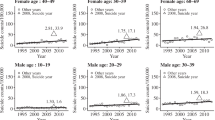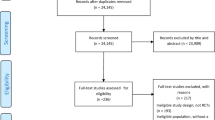Abstract
Background
The effect of celebrity suicides on copycat suicide attempts is not well known. Our objective was to determine the association between celebrity suicide and copycat suicide attempts.
Methods
We conducted a retrospective multicenter observational time series analysis. Celebrity suicides were selected by an operational definition via three nationwide television news internet sites from January 2005 to December 2008. The reference week was defined as the week preceding date of suicide notification to the public. Then two pre-event weeks and four post-event weeks were analyzed for suicide attempts. We derived a prediction model for suicide attempt visits for each ED for these seven observational weeks using a General Additive Model with data from the National Emergency Department Information System (NEDIS) database. We calculated the mean excess visit (EV = observed visit − expected visit) and mean excess visit ratio (EVR = EV/expected visit). We tested the mean EV and EVR between reference weeks versus the observational weeks using independent t test and repeated measures ANOVA.
Results
Five celebrity suicides occurred during the study period. Total number of ED visits was 5,453,441 in the 85 EDs over the 4-year period, and suicide attempt or self-injury occurred in 27,605. The mean excess visit for each observational interval per ED was less than 0.1 during pre-event periods but increased to 0.695 in the second post-event week. EVs were significantly higher in the first to the third post-event weeks (p = 0.02, p < 0.01, p = 0.03, respectively) compared to reference week. The mean EVRs were significantly higher (=0.215) in the second post-week intervals compared with the reference week (p = 0.03). Mean EVs and mean EVRs showed significant increase in the post event period compared with the observational period (p = 0.001 in EV, p = 0.021 in EVR).
Conclusion
From a prediction model using a 4-year nationwide ED database, ED visits for suicide attempts or self injury increased following the announcements of celebrity suicides.

Similar content being viewed by others
References
Cha WC, Shin SD, Song KJ, Jung SK, Suh GJ (2009) Effect of an independent-capacity protocol on overcrowding in an urban emergency department. Acad Emerg Med 16:1277–1283
Cheng AT, Hawton K, Chen TH, Yen AM, Chen CY, Chen LC, Teng PR (2007) The influence of media coverage of a celebrity suicide on subsequent suicide attempts. J Clin Psychiatry 68:862–866
Cheng AT, Hawton K, Lee CT, Chen T (2007) The influence of media reporting of the suicide of a celebrity on suicide rates: a population-based study. Int J Epidemiol 36:1229–1234
Etzersdorfer E, Voracek M, Sonneck G (2004) A dose-response relationship between imitational suicides and newspaper distribution. Arch Suicide Res 8:137–145
Fu KW, Yip PS (2009) Estimating the risk for suicide following the suicide deaths of 3 Asian entertainment celebrities: a meta-analytic approach. J Clin Psychiatry 70:869–878
Hastie TJ, Tibshirani RJ (1990) Generalized additive models. Chapman and Hall, New York
Hawton K (2009) Suicide. Lancet 373:1372–1381
Hawton K, Harriss L, Simkin S, Juszczak E, Appleby L, McDonnell R, Amos T, Kiernan K, Parrott H (2000) Effect of death of Diana, princess of Wales on suicide and deliberate self-harm. Br J Psychiatry 177:463–466
Internet World Stats (2010) http://www.internetworldstats.com/asia/kr.htm. Accessed 3 January 2010
Niederkrotenthaler T, Till B, Herberth A, Kapusta ND, Voracek M, Dervic K, Etzersdorfer E, Sonneck G (2009) Can media effects counteract legislation reforms? The case of adolescent firearm suicides in the wake of the Austrian firearm legislation. J Adolesc Health 44:90–93
Phillips DP (1974) The influence of suggestion on suicide: substantive and theoretical implications of the Werther effect. Am Sociol Rev 39:340–354
Pirkis JE, Burgess PM, Francis C, Blood RW, Jolley DJ (2006) The relationship between media reporting of suicide and actual suicide in Australia. Soc Sci Med 62:874–886
Schmidtke A, Häfner H (1988) The Werther effect after television films: new evidence for an old hypothesis. Psychol Med 18:665–676
Stack S (2003) Media coverage as a risk factor in suicide. J Epidemiol Community Health 57:238–240
Television in South Korea (2010) http://en.wikipedia.org/wiki/Television_in_South_Korea. Accessed 3 January 2010
Tousignant M, Mishara BL, Caillaud A, Fortin V, St-Laurent D (2005) The impact of media coverage of the suicide of a well-known Quebec reporter: the case of Gaetan Girouard. Soc Sci Med 60:1919–1926
Ueda K, Nitta H, Ono M, Takeuchi A (2009) Estimating mortality effects of fine particulate matter in Japan: a comparison of time-series and case-crossover analyses. J Air Waste Manag Assoc 59:1212–1218
World Health Organization (2010) Preventing suicide. http://whqlibdoc.who.int/publications/2006/9241594314_eng.pdf. Accessed 3 January 2010
Yip PS, Fu KW, Yang KC, Ip BY, Chan CL, Chen EY, Lee DT, Law FY, Hawton K (2006) The effects of a celebrity suicide on suicide rates in Hong Kong. J Affect Disord 93:245–252
Author information
Authors and Affiliations
Corresponding author
Appendix: General additive model
Appendix: General additive model
The methods described here represent a generalization of multiple regressions (which is a special case of general linear models). Specifically, in linear regression, a linear least-squares fit is computed for a set of predictor or X variables, to predict a dependent Y variable. The well known linear regression equation with m predictors, to predict a dependent variable Y, can be stated as:
where Y is predicted values of the dependent variable, X 1 through X m values for the predictor variables, b 0, and b 1 through b m the regression coefficients estimated by multiple regression.
A generalization of the multiple regression model would be to maintain the additive nature of the model, but to replace the simple terms of the linear equation b i *X i with f i (X i ) where f i is a non-parametric function of the predictor X i . In other words, instead of a single coefficient for each variable (additive term) in the model, in additive models an unspecified (non-parametric) function is estimated for each predictor, to achieve the best prediction of the dependent variable values.
The generalized linear model instead of general linear model is better when the dependent variable is non-normal and the dependent variable values are predicted from a linear combination of predictor variables via a link function. To illustrate, in the general linear model a response variable Y is linearly associated with values on the X variables while the relationship in the generalized linear model is assumed to be
where g(…) is a function. Formally, the inverse function of g(…), say gi(…), is called the link function; so that:
where mu-Y stands for the expected value of Y.
Generalized Additive Models allows you to choose from a wide variety of distributions for the dependent variable, and link functions for the effects of the predictor variables on the dependent. Normal, gamma, and Poisson distributions are follows:
We can summarize the final model, combining the notion of additive models with generalized linear models, to derive the notion of generalized additive models, as:
In other words, the purpose of generalized additive models is to maximize the quality of prediction of a dependent variable Y from various distributions, by estimating unspecific (non-parametric) functions of the predictor variables which are “connected” to the dependent variable via a link function.
The final model was as follows (allowing all EDs a specific prediction model):
E(W) is expected number, x i week (k = 4, degree of freedom), S smoothing of splines, D is the dummy variable for adjustment.
The S (cubic spline scatter plot smoother) is a special smoothing technique for 2-dimension scatter plots, which generally produces a smooth generalization of the relationship between the two variables in the scatter plot. The cubic spline smoother is often used in generalized additive models, to estimate the unspecific (non-parametric) function of the predictor variables that best predicts the (transformed) dependent variable values [6].
Rights and permissions
About this article
Cite this article
Jeong, J., Shin, S.D., Kim, H. et al. The effects of celebrity suicide on copycat suicide attempt: a multi-center observational study. Soc Psychiatry Psychiatr Epidemiol 47, 957–965 (2012). https://doi.org/10.1007/s00127-011-0403-7
Received:
Accepted:
Published:
Issue Date:
DOI: https://doi.org/10.1007/s00127-011-0403-7




